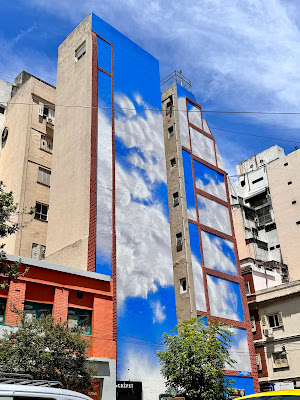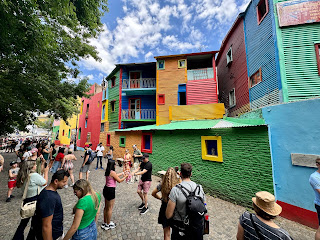We've arrived back in Buenos Aires from Ushuaia and are looking forward to exploring the City. On the way to our cruise we saw a bit of the city, but we didn't have time to get out and about. This time, we're here for two nights before heading home for New Year's.
Because of our late afternoon arrival, we could only visit a couple of sites, but fortunately they were close to our hotel. We're staying in the heart of the city -- Microcentro -- within easy walking distance to several areas to explore. First up is the Obelisco de Buenos Aires (Obelisk).
The Obelisk is in the middle of the Plaza de la Republica along the main boulevard through the city -- Avenida 9 de Julio. It was erected in 1936 to celebrate the quadricentennial of the founding of the city by Spanish explorers. Avenida 9 de Julio is named for Argentina's July 9 Independence Day. It is a popular spot in the city, and in some ways it resembles Time Square in New York City- especially at night. Besides large groups of people, there are huge screens on every corner broadcasting advertisements.
 |
| Teatro Colon |
On the way to the Obelisk we stopped by Teatro Colon, the grand opera house that saw its first performance in 1908. It's considered one of the great opera houses of the world, and the names of singers, musicians, and conductors who have performed here are a who's who of classical music. Unfortunately, we didn't have time to take a tour of the interior, so that will be during a future visit.

We capped our evening with dinner at Pizzeria Guerrin, founded in 1932 and one of the oldest pizzerias in the city. Argentina is well known for beef and Malbec wine, so why we would we go eat pizza? Over two million Italians immigrated to Argentina between 1880 and 1920, bringing with them their traditional cuisine. And it's not just pizza, but pasta and pastries as well. Pizzeria Guerrin has thick, airy slices and lots of cheese. Our pizza was no exception, lightly sauced and very fresh. The crust reminded us of focaccia. We stuck with our traditional favorite of pepperoni, with wine for Mona and a beer for me.
The restaurant was HOPPING! It was two levels and a small mezzanine and every table was full so people were waiting.
While I'm sure there were other tourists, it definitely had the feel of a local place where we were one of the very few people speaking English. We left about 9:30pm, and there was a line of at least 100 people just waiting to get in, let alone the 200-300 people already inside. Our online research indicated it was the best and most popular pizza in Buenos Aires. The number of people there definitely confirmed it. It's a good thing our eating at 8pm was eating early for the locals.
 |
| Huge line waiting to get in |































